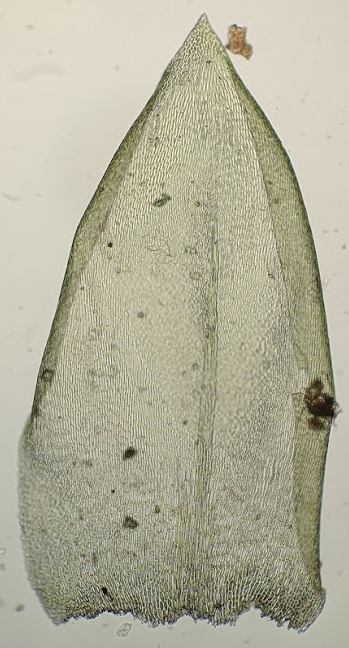Camptochaete deflexa
(Wilson ex Müll.Hal.) A.JaegerWefts on rocks, logs, tree bases or occasionally soil. Secondary stems 40–80 (–100) mm long; central strand indistinct. Stipes usually weakly or rarely well developed, 10–15 (–20) mm long. Fronds 2–4.5 cm wide, densely and regularly bipinnately branched. Stipe leaves appressed, imbricate, broadly triangular, (1.1–) 1.3–1.6 mm long, 1.1–1.3 mm wide, weakly concave; apex acuminate; margins entire, plane or incurved on one side toward apices. Frond axis leaves patent, imbricate, moderately complanate, ovate, (1.4–) 1.6–2 (–2.4) mm long, 0.6–1.2 mm wide, concave, rarely weakly striate, not or scarcely wrinkled when dry; apex acuminate, often cuspidate; margins entire, plane or erect. Branch leaves (0.9–) 1.2–1.6 mm long, 0.5–0.9 mm wide. Costa weak, double and failing below mid-leaf or sometimes absent. Mid-laminal cells linear, (32–) 40–60 (–67) μm long, 5 μm wide; laminal cells near apex 12–45 μm long, 5–8 μm wide; alar cells quadrate, irregular or rectangular, c. 4–15 μm long, c. 3–9 μm wide, forming a group that extends c. 6 (–12) cells toward apices and c. 4–6 (–10) cells wide. Seta 8–10 mm long, reddish-brown, smooth. Capsule erect to horizontal, ellipsoid, straight, c. 2 mm long. Operculum blunt or apiculate, c. 0.6 mm long.
GleP, VVP, GipP, OtP, WaP, CVU, GGr, NIS, EGL, EGU, WPro, HSF, HNF, OtR, Strz, MonT, HFE, VAlp. Widespread, occurring in the Grampians, central highlands and high rainfall areas south of the Great Dividing Range in rainforest and wet-sclerophyll forest or beside creeks and waterfall among drier vegetation. Also QLD, NSW, ACT and Tas. New Zealand and Auckland, Campbell and Chatham Islands.
 Spinning
Spinning
